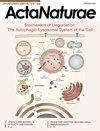Tgfb1基因单倍型与儿童肝病的相关性分析。
IF 2
4区 生物学
Q4 CELL BIOLOGY
引用次数: 0
摘要
转化生长因子-β1(TGF-β1)是一种具有免疫抑制和促纤维化活性的细胞因子,是感染、肝移植排斥反应和纤维化的潜在标志物。它在血液和组织中的水平取决于许多因素;然而,基因多态性的作用尚不清楚。在这项工作中,研究了三种Tgfb1基因单核苷酸多态性(SNP)变体,即rs1800469、rs1800470和rs1800471在终末期肝病(ESLD)儿童中的分布频率。该研究包括225名年龄在1个月至16岁(中位数为8个月)的儿童肝脏接受者,包括100名男孩和125名女孩,以及198名年龄在32.7±9.6岁的健康人,包括78名男性和120名女性。儿童肝移植的适应症是ESLD,它主要由先天性和遗传性肝病引起。使用TaqMan探针和从外周血中分离的DNA通过实时聚合酶链式反应检测SNPs。SNP频率分布处于Hardy-Weinberg平衡,肝病儿童和健康儿童之间没有差异。基于等位基因相互作用模型的SNPs频率分析没有揭示患者和健康个体之间的任何差异。Tgfb1多态性变异体对的连锁不平衡评估显示,所有研究变异体之间存在统计学上显著的连锁。在研究的患者和健康个体组中观察到七种单倍型,它们是SNP组合的变体。该组共有80%的人有三种单倍型,其频率在患者和健康个体之间没有差异。发现A-A-C、G-G-C和G-A-G单倍型的频率存在显著差异(分别为rs1800469、rs1800470和rs1800471),与健康个体相比,受体的单倍型频率高达11倍。这些单倍型可能是易患ESLD的变体,这也可能导致儿童肝移植后并发症的发展。本文章由计算机程序翻译,如有差异,请以英文原文为准。

Analysis of the Association between the Tgfb1 Gene Haplotype and Liver Diseases in Children.
Transforming growth factor-β1 (TGF-β1), a cytokine with immunosuppressive and pro-fibrogenic activity, is a potential marker of infection, liver transplant rejection, and fibrosis. Its levels in the blood and tissues depend on many factors; however, the role of gene polymorphism is still unclear. In this work, the distribution frequency of three single nucleotide polymorphism (SNP) variants of the Tgfb1 gene, namely rs1800469, rs1800470, and rs1800471, was studied in children with end-stage liver disease (ESLD). The study included 225 pediatric liver recipients aged 1 month to 16 years (median, 8 months), including 100 boys and 125 girls, and 198 healthy individuals aged 32.7 ± 9.6 years, including 78 men and 120 women. The indication for liver transplantation in children was ESLD, which was mostly caused by congenital and inherited liver diseases. SNPs were detected by real-time polymerase chain reaction using TaqMan probes and DNA isolated from peripheral blood. SNP frequency distribution was in Hardy–Weinberg equilibrium and did not differ between children with liver diseases and the healthy ones. Analysis of the SNPs frequency based on allelic interaction models did not reveal any differences between patients and the healthy individuals. Evaluation of linkage disequilibrium for Tgfb1 polymorphic variant pairs revealed a statistically significant linkage between all studied variants. Seven haplotypes, which are variants of SNP combinations, were observed in the studied groups of patients and healthy individuals. A total of 80% of the group had three haplotypes, whose frequencies did not differ between patients and the healthy individuals. Significant differences were found in the frequency of the haplotypes A-A-C, G-G-C, and G-A-G (at rs1800469, rs1800470, and rs1800471, respectively), which were observed up to 11 times more often in recipients compared to the healthy individuals. It is possible that these haplotypes are ESLD-predisposing variants, which may also contribute to the development of complications after liver transplantation in children.
求助全文
通过发布文献求助,成功后即可免费获取论文全文。
去求助
来源期刊

Acta Naturae
农林科学-林学
CiteScore
3.50
自引率
5.00%
发文量
0
审稿时长
>12 weeks
期刊介绍:
Acta Naturae is an international journal on life sciences based in Moscow, Russia.
Our goal is to present scientific work and discovery in molecular biology, biochemistry, biomedical disciplines and biotechnology. These fields represent the most important priorities for the research and engineering development both in Russia and worldwide. Acta Naturae is also a periodical for those who are curious in various aspects of biotechnological business, innovations in pharmaceutical areas, intellectual property protection and social consequences of scientific progress. The journal publishes analytical industrial surveys focused on the development of different spheres of modern life science and technology.
Being a radically new and totally unique journal in Russia, Acta Naturae is useful to both representatives of fundamental research and experts in applied sciences.
 求助内容:
求助内容: 应助结果提醒方式:
应助结果提醒方式:


